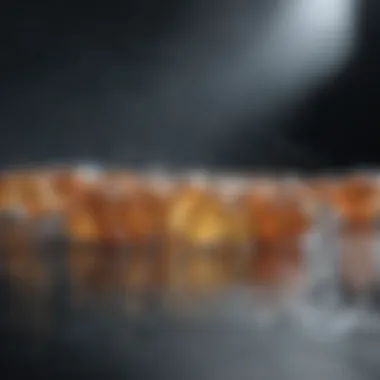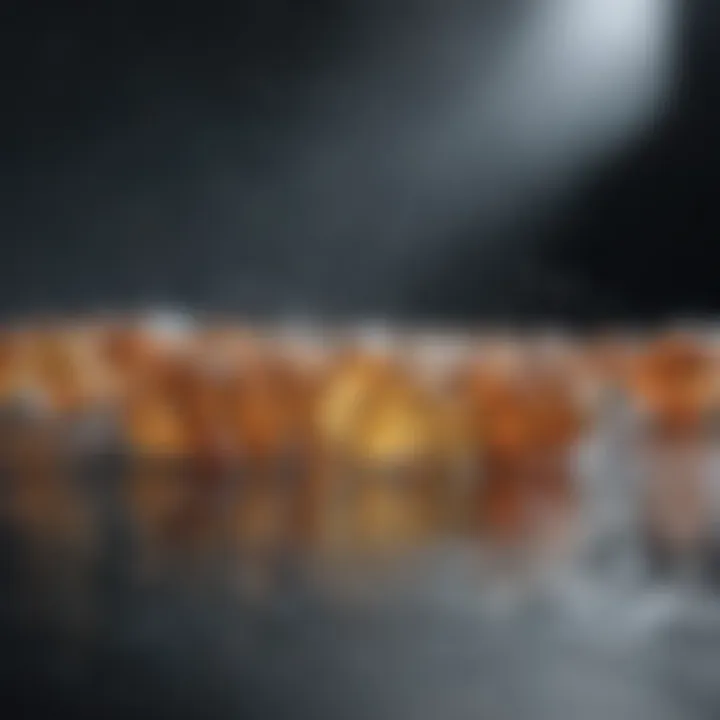Understanding Water Vapor Permeability in Materials


Intro
Water vapor permeability stands as a crucial element in the realm of material science. Its influence stretches across diverse fields, including construction, textiles, and packaging, where understanding the movement of moisture can significantly affect the integrity and longevity of materials. Yet, despite its significance, this topic is often overshadowed by more glamorous material properties like tensile strength or thermal resistance. This article aims to bring water vapor permeability into the spotlight, exploring its fundamental principles, implications, and vital relevance.
Article Overview
Purpose of the Article
This article's primary goal is to dissect the multifaceted role of water vapor permeability within material science. Delving into the principles of water vapor transmission, it will unravel how this parameter impacts the performance of materials. In examining various applications—from the durability of building materials to the comfort of clothing—this piece aspires to enhance one's understanding of how vital water vapor management is in ensuring material longevity and functionality.
Relevance to Multiple Disciplines
Water vapor permeability touches several disciplines:
- Construction: where the integrity of materials directly affects structural safety.
- Textiles: influencing wearer comfort and performance.
- Packaging: affecting shelf life and product quality.
In each of these sectors, the ability to appropriately manage moisture can mean the difference between success and failure.
Research Background
Historical Context
The significance of water vapor permeability has long been acknowledged, albeit often indirectly. Traditionally, construction materials were tested for other mechanical properties, leaving moisture transmission somewhat unaddressed. Over time, as the materials used in buildings, clothing, and packaging evolved, researchers began to recognize that moisture management is just as essential as durability or aesthetic appeal.
Key Concepts and Definitions
Understanding this topic requires familiarity with specific concepts:
- Water Vapor Transmission Rate (WVTR): This metric measures how much water vapor passes through a material over a specified time and area.
- Permeability Coefficient: Signifying a material's ability to resist water vapor flow, this number is key to assessing overall performance.
- Diffusion: The process by which water vapor moves through materials, driven by a gradient in vapor pressure.
These terms provide a framework for discussing water vapor permeability and its significance in various applications.
Prelims to Water Vapor Permeability
Water vapor permeability is a critical aspect of material science that influences how materials perform in various environments. Understanding this property is crucial for engineers, architects, and product designers, as it informs choices in material selection and application. Water vapor can permeate through different materials, impacting their durability, performance, and even hygiene. As climate change and energy efficiency become increasingly important, factors such as heat and moisture transfer are now at the forefront of design considerations.
When we dive into water vapor permeability, we uncover several elements that are key to material innovation. Firstly, it helps us evaluate how well a material manages moisture, which in turn affects mold growth and structural integrity. Secondly, it plays a pivotal role in ensuring the comfort of textiles and apparel, from sportswear to everyday clothing. Lastly, in the realm of packaging, water vapor control is vital for food and drug preservation, ensuring product longevity and quality.
There are considerations one must keep in mind regarding water vapor permeability. Not all materials are created equal; their ability to allow vapor transmission varies significantly. Environmental factors such as temperature and humidity also interact with material properties, further complicating assessments. Therefore, comprehending water vapor permeability is not merely a science; it encompasses a multifaceted approach that combines engineering principles, environmental science, and consumer needs.
Definition and Importance
Water vapor permeability can be defined as the measure of ability of a material to allow water vapor to pass through it. In simpler terms, it's how much moisture a material lets escape or enter. This property is particularly significant in fields such as construction and textiles. For instance, inappropriate vapor control in buildings can lead to condensation problems, which in turn may foster mold and other structural issues.
In textiles, breathability is a prime factor that consumers often seek. It can dictate the comfort of clothing, especially for active individuals who require fabrics that wick moisture away from the skin. Hence, manufacturers need to consider water vapor permeability when designing their products to meet end-user expectations effectively.
Historical Context
The study of water vapor permeability is not a modern development; it has historical roots that trace back centuries. Early civilizations understood that materials interacted with water in the environment but often did so through trial and error. For example, ancient builders would notice that certain materials would keep their structures dryer during rain or moisture-laden conditions.
As scientific understanding evolved, researchers began formalizing methodologies to measure water vapor transmission rates. The 20th century saw a significant uptick in interest due to the rise of indoor climate control. Engineers and architects recognized the importance of managing moisture in buildings, leading to the development of specific construction materials aimed at improving performance in various climates.
The advancements in material science have continued to propel this area forward, bringing forth innovations such as breathable membranes and moisture-regulating textiles. This historical backdrop reveals that the journey of understanding water vapor permeability has always been tied to the broader goals of protecting structures and enhancing human comfort.
"Understanding how materials interact with water is not just a matter of efficiency; it's essential for sustainability and durability in design."
"Understanding how materials interact with water is not just a matter of efficiency; it's essential for sustainability and durability in design."
Ultimately, as we delve further into this article, it becomes apparent that water vapor permeability is more than a technical measurement; it's a fundamental property that shapes the functional life and performance of materials.
Fundamental Principles of Water Vapor Permeability
Understanding water vapor permeability is crucial in the realm of material science because it provides insight into how and why materials behave under varying environmental conditions. The significance of this permeability isn’t just a stat; it affects the durability, performance, and overall functionality of materials across a multitude of applications — from construction to textiles and beyond. The principles of water vapor permeability delve into how moisture moves and interacts with material surfaces, dictating their suitability for specific uses, especially in sectors where moisture control is paramount.
Diffusion Mechanisms
Water vapor permeability fundamentally relies on the diffusion mechanisms that dictate how water vapor passes through a material. This process can be influenced by multiple factors, including molecular size, temperature, and pressure differentials. In simple terms, diffusion is like a game where molecules move from a crowded area to a less populated one, aiming for balance in concentration.
In solid materials, for example, water vapor molecules may pass through tiny spaces in the structure. The speed and efficiency of this movement can vary greatly depending on the nature of the material itself. Some materials are, therefore, better suited for specific environments than others.
Factors Influencing Permeability
A deeper analysis of water vapor permeability reveals several key factors affecting its behavior. Here, we will explore three major contributors:


Temperature Effects
Temperature plays a significant role in water vapor permeability, as warmer conditions typically increase the kinetic energy of vapor molecules. Consequently, this increase in energy allows molecules to move more freely, which enhances the rate of diffusion through materials.
- Key Characteristic: As temperatures rise, the permeability of materials can increase.
- Benefit: This characteristic is advantageous in applications requiring rapid moisture release, such as in some insulation materials.
- Unique Feature: One drawback, however, is that elevated temperatures may also lead to the degradation of certain materials over time, which can compromise their structural integrity.
Humidity Conditions
Humidity conditions are another essential factor when discussing water vapor permeability. The presence of moisture in the air impacts how much water vapor the material can absorb or release. It’s a delicate balance; materials that are too permeable may take on excess moisture, while those that are too impermeable can lead to moisture buildup.
- Key Characteristic: High humidity often leads to increased vapor transmission, as the concentration of vapor in the air pushes water molecules towards less concentrated areas within the material.
- Benefit: Understanding these dynamics can be particularly beneficial for creating breathable materials in clothing, which must manage moisture to ensure comfort and functionality.
- Unique Feature: An excessive level of humidity, though, can lead to issues like mold growth and material weakening, which is a significant concern in construction.
Material Structure
The structure of a material fundamentally influences its water vapor permeability. Different materials possess diverse structural properties—like porosity and thickness—that directly impact how easily water vapor can move through them.
- Key Characteristic: Materials with higher porosity, such as certain types of fabrics or porous stones, usually have a higher permeability.
- Benefit: This is beneficial for specific applications, such as in insulative layers that need to release moisture to maintain effectiveness.
- Unique Feature: Conversely, denser materials, while robust, might not allow moisture to pass, which can create problems in environments where breathability is crucial.
Understanding these fundamental principles is vital for researchers and practitioners as they explore new materials and applications in engineering, construction, and other fields.
Understanding these fundamental principles is vital for researchers and practitioners as they explore new materials and applications in engineering, construction, and other fields.
Measurement Techniques for Water Vapor Permeability
Understanding how to measure water vapor permeability is pivotal in material science. This could mean the difference between a product that performs well over time and one that fails prematurely. Various measurement methods not only serve as yardsticks for permeability but also aid in tailoring materials for specific applications, reflecting their potential in everyday life.
The chosen technique often influences the results, and correcting for nuances or inconsistencies in measurement can significantly affect the interpretation of data. Material properties, environmental conditions, and application contexts play into these methods, lending each its unique set of advantages and limitations.
"Selecting the right measurement technique is like picking the right tool for a job; use the wrong one, and you'll be left in the lurch."
"Selecting the right measurement technique is like picking the right tool for a job; use the wrong one, and you'll be left in the lurch."
Desiccant Method
The desiccant method is one of the most established approaches for evaluating water vapor permeability. At its core, this technique determines how much moisture a material allows to pass through by exposing it to a desiccant, which is a substance that absorbs moisture. One common desiccant used is silica gel. The process typically involves placing the material in a sealed environment with the desiccant and measuring the weight change over time.
Key Points about the Desiccant Method:
- Simplicity: It's straightforward and doesn’t require advanced equipment.
- Cost-Effective: Relatively inexpensive compared to some other methods.
- Sensitivity: Good for materials with lower permeability but may not capture rapid changes accurately.
However, this method has limitations, especially with highly permeable materials or when rapid moisture transfer occurs. Additionally, the accuracy can waver depending on factors like temperature and relative humidity, so caution is warranted when interpreting results.
Dynamic Water Vapor Sorption
Dynamic water vapor sorption is another approach that plays a significant role in measuring water vapor permeability. This technique involves subjecting the material to controlled humidity levels and monitoring the rate of moisture uptake or release. By creating a dynamic environment, researchers can glean insights into how the material behaves under different conditions, making it particularly useful in applications where humidity fluctuates frequently.
Benefits of Dynamic Water Vapor Sorption:
- Real-Time Data: Provides continuous monitoring of moisture interactions.
- Detailed Insights: Can uncover intricate absorption and desorption behaviors.
- Adaptability: Applicable for a wide range of materials, including polymers and textiles.
But this method can be resource-intensive. It often requires sophisticated equipment and can be more expensive than traditional methods. Despite that, the depth of data obtained can be invaluable in material selection and design.
Infrared Spectroscopy
Infrared spectroscopy is somewhat different from the previous methods but no less important. It uses infrared radiation to analyze the vibrational transitions in molecules within the material. When water vapor comes into play, the changes in the material's molecular structure are captured, translating them into permeability data.
Why Choose Infrared Spectroscopy?
- High Precision: Offers detailed molecular-level insights that can enhance understanding of the material's behavior.
- Versatility: Suitable for various types of materials ranging from films to coatings.
- Non-Destructive: Allows measurement without altering the material’s structure, which is crucial for maintaining sample integrity.
While infrared spectroscopy is a powerful tool, it does come with its own set of challenges. Setting up the equipment can be complex, and interpreting the data requires a high level of expertise.
In summary, selecting an appropriate measurement technique for water vapor permeability is critical. Each method holds unique strengths and weaknesses that can greatly influence the resultant data, ultimately guiding decisions in material selection and application. Hence, understanding these techniques in-depth allows scientists and engineers to make informed choices that support their objectives in material innovation and sustainability.
Applications of Water Vapor Permeability
Water vapor permeability plays a pivotal role across various sectors, influencing how materials interact with moisture in their environments. This characteristic is especially important when evaluating materials for construction, textiles, and packaging. Understanding the intricacies of water vapor permeability helps in not only selecting the right materials but also in enhancing product longevity and functionality.
Construction Materials
Insulation
In construction, the permeability of insulation materials becomes crucial. These materials are designed to control heat transfer but they also need to manage moisture effectively. One of the key characteristics of insulation is its ability to resist water vapor, minimizing condensation within walls or ceilings. This aspect is beneficial because it helps maintain structure integrity and prevents mold growth, which is a common issue in buildings.
A unique feature of modern insulation, such as spray foam, is its closed-cell structure that creates an effective barrier against water vapor. However, it's important to note that while closed-cell foam offers excellent moisture resistance, it may trap humidity if the building envelope is not correctly managed.


Membranes
Membranes serve as another critical application in construction. They play an essential role in protecting buildings from water and moisture while allowing vapor to escape. A prominent example is the use of breathable membranes in roofing and wall systems. This characteristic enables moisture that might accumulate during the building process to evaporate rather than becoming trapped and causing damage over time.
These membranes are popular because they strike a balance between waterproofing and breathability, making them suitable for varying climates. However, the selection of a membrane must consider factors like the specific environmental conditions and material compatibility to avoid failures in moisture control.
Textiles and Apparel
Breathability in Clothing
Breathability in clothing is a significant aspect of textile engineering. When discussing water vapor permeability in apparel, it primarily concerns how effectively fabrics allow sweat to escape. This property can dramatically affect comfort, especially in activewear.
One key characteristic of breathable fabrics, like those made from merino wool or high-performance synthetic fibers, is their capability to wick moisture away from the skin. This feature is increasingly in demand, making such materials popular among consumers who prioritize functionality in high-intensity activities. However, it's notable that while increased breathability enhances comfort, it may lower the garment's waterproof capabilities.
Moisture Management in Fabrics
Moisture management is another vital factor in textiles, focusing on how fabrics handle not just perspiration, but environmental moisture as well. Water vapor permeability is crucial for maintaining an ideal microclimate next to the skin, which is particularly important for outdoor and sports clothing.
For example, newer polyester blends with integrated moisture-wicking technology are developed to both manage moisture and provide ventilation. The dual advantage leads to improved performance and user satisfaction in fluctuating conditions. Yet, ongoing care about durability and wear resistance remains paramount amid these advances, as certain moisture management treatments can wear off over time.
Packaging Solutions
Food Preservation
In the realm of packaging, understanding water vapor permeability is vital for food preservation. Packaging materials are engineered to create barriers that extend shelf life, maintaining the freshness of food products. One notable characteristic of effective food packaging is low permeability to moisture, which prevents spoilage and reduces waste.
A distinct advantage of using high-barrier films, for instance, lies in their ability to significantly slow down moisture transfer, which is essential for products like dry snacks or frozen foods that are sensitive to humidity. On the downside, overly impermeable packaging can lead to issues like lack of respiration for fresh products, necessitating a precise balance in material selection.
Pharmaceutical Packaging
Pharmaceutical packaging is another critical area where water vapor permeability is imperative. The integrity of medicines can depend heavily on their packaging, particularly concerning moisture sensitive compounds. One key characteristic is the use of blister packs, designed to protect tablets from moisture and gases while allowing easy access.
Such specialized packaging is beneficial as it can significantly extend the shelf life of medications, ensuring efficacy is maintained until the point of use. However, while these materials are effective, they often require careful consideration of cost versus protective benefits, as optimal packaging solutions can be more expensive but ultimately save money by minimizing product spoilage.
Environmental Impact and Sustainability
Water vapor permeability plays a crucial role in material science, influencing not only the performance of materials but also their environmental footprint. As society grows increasingly aware of sustainability and energy efficiency, the significance of understanding water vapor transmission cannot be overstated. This section delves into how water vapor permeability connects to energy efficiency and the development of biodegradable materials, showcasing both the challenges and opportunities that lie ahead.
Role in Energy Efficiency
One vital aspect of water vapor permeability is its impact on energy efficiency, especially in the construction sector. Materials with optimal water vapor properties can regulate temperature and humidity levels within buildings, reducing reliance on HVAC systems. This is particularly relevant in climates with extreme conditions, where better insulation means lower energy consumption.
"The ability of a material to allow moisture to escape without compromising thermal resistance is like having your cake and eating it too."
"The ability of a material to allow moisture to escape without compromising thermal resistance is like having your cake and eating it too."
For instance, breathable membranes used in wall systems permit moisture from inside to escape, while preventing external moisture from penetrating. This not only helps in avoiding problems such as mold growth but also enhances the energy efficiency of buildings. When buildings can manage humidity effectively, they operate more efficiently, leading to decreased energy bills and a smaller carbon footprint.
Additionally, water vapor diffusion plays a significant role in the lifecycle analysis of materials. By selecting materials that excel in vapor permeability, construction firms can design structures that use less energy over time, thereby aligning with global sustainability goals.
Biodegradable Materials
The conversation around biodegradable materials is becoming more critical as the planet grapples with waste and pollution. Water vapor permeability is also a key factor when it comes to the development of biodegradable plastics and packaging solutions. These materials must balance effective moisture management while ensuring they don't degrade too quickly under the conditions they are designed for, such as during transportation or storage.
Research is underway to develop biodegradable materials that can mimic the water vapor permeability characteristics of traditional plastics. For example, formulations incorporating natural polymers show promise, as they can provide sufficient moisture barrier properties while eventually breaking down without leaving harmful residues behind.
It is essential to address two main considerations during this process:
- Compatibility with existing systems: New biodegradable materials must be compatible with current manufacturing and recycling processes to ensure smooth integration into existing supply chains.
- Performance under various conditions: Understanding how these materials respond in different environments is crucial. Humidity can affect their longevity and effectiveness, which must be considered during design and testing.
By focusing on water vapor permeability, the industry can push forward towards more sustainable practices that not only cater to current market demands but also lay the groundwork for future innovations. Integrating these principles into material science will ensure that we not only address today's environmental challenges but also pave the way for a greener tomorrow.
Challenges in Measuring and Specifying Water Vapor Permeability
Measuring and specifying water vapor permeability simultaneously poses significant challenges in material science. These difficulties can stem from a variety of factors including the wide range of materials available and their unique interaction with moisture. As water vapor plays a pivotal role across many industries, particularly in construction and textiles, understanding these challenges is essential for selecting the right materials for specific applications.
One major element that complicates measurements is the lack of consistent protocols. This inconsistency means that results from one laboratory might not match those from another, leading to confusion and potentially false assumptions about a material's capabilities. When comparing materials, if the methodologies differ, it can create discrepancies that obscure a clear picture of performance.
Additionally, as materials evolve, so do the conditions under which their permeability is gauged. While some tests might be done in controlled environments, real-world applications can vary wildly. Thus, knowing how a material behaves under different humidity and temperature scenarios is vital.
"The situation is akin to trying to hit a moving target—one must keep honing the aim as conditions change."
"The situation is akin to trying to hit a moving target—one must keep honing the aim as conditions change."


Not just the methods, but the materials themselves pose complications. For instance, porous substances may offer vastly different permeability values based on their structure. Therefore, standardizing measurements becomes crucial, yet remains elusive.
Ultimately, grasping these challenges is not only beneficial but necessary for furthering material science. It opens a dialogue towards improving testing methods and aids in developing better materials that can withstand the demands of various environments.
Standardization Issues
Standardization issues are a significant hurdle in accurately assessing water vapor permeability. The absence of universally accepted testing methodologies leads to a patchwork of standards that vary by region, industry, and even specific applications. This lack of uniformity complicates comparisons across studies or products – an engineer may find it difficult to determine whether material A performs better than material B if the tests conducted were not aligned.
Furthermore, consider the discrepancies that arise when materials are tested using different apparatus and environmental conditions. For example, a membrane tested in a lab might show a different permeability than when installed in a building. These deviations can mislead manufacturers and professionals who are attempting to make data-driven decisions about product selection.
Understanding standardization isn't just a matter of academic interest; it's applicable to practical concerns. Improved standards may lead to better design choices and ultimately to the development of greener, more energy-efficient materials.
Variability in Results
Variability in results is another pressing challenge in the context of measuring water vapor permeability. Differing results can stem from multiple sources, including material composition, the structure of the test specimens, and even minute fluctuations in environmental conditions during testing. For instance, a slight increase in temperature or change in humidity levels can alter the results significantly.
Moreover, the role of humidity cannot be overstated. Most materials behave differently under variable moisture levels, which means that any slight change in humidity can yield a noticeable difference in results. For example, a high permeability value under dry conditions may not hold true in a saturated environment, leading to potentially misleading conclusions about a material's suitability for specific applications.
To make matters worse, the testing methods themselves might introduce variability. Some techniques may be more sensitive to changes than others, leading to an inconsistency in reporting. This lack of reliability could cause professionals to make choices based on flawed data, affecting everything from construction efficacy to product lifespan.
Addressing these variabilities involves not only refining measurement techniques but also understanding their limitations. Recognizing the inherent challenges in assessing water vapor permeability leads to improved practices in material selection, making it a crucial endeavor for material scientists and engineers alike.
Future Directions in Water Vapor Permeability Research
As the understanding of material science evolves, exploring future directions in water vapor permeability research becomes crucial. This exploration touches on how advanced materials and innovative techniques could reshape applications in construction, textiles, and packaging, promoting efficiency and sustainability.
Emerging Materials
Researchers are continually on the lookout for emerging materials that can offer enhanced water vapor permeability without compromising other critical properties. One area of interest is biomimicry, where scientists study natural structures to replicate their effectiveness. For instance, certain plant leaves exhibit extraordinary water management capabilities. Engineers are investigating these biological systems to develop synthetic materials that can mimic such functions effectively.
Furthermore, nanostructured materials present vast potential in controlling vapor permeability. By manipulating material at the nanoscale, scientists can create filters or barriers that selectively allow moisture to pass through while blocking larger molecules. This characteristic not only benefits packaging solutions but can also improve insulation materials in construction.
"The study of biomimetic and nanostructured materials could lead to sustainable innovations that fundamentally alter design principles in material sciences."
"The study of biomimetic and nanostructured materials could lead to sustainable innovations that fundamentally alter design principles in material sciences."
Such materials give rise to a new generation of solutions, which may provide properties that are light, flexible, and high-performing. These advances may meet the increasing demand for sustainable and eco-friendly practices across various industries.
Advanced Measurement Techniques
To keep pace with these developing materials, advanced measurement techniques for water vapor permeability are equally crucial. Traditional methods may not adequately capture the behaviors of novel materials under varying conditions. Thus, researchers are focusing on high-resolution techniques that can accurately measure permeability at different temperatures and humidity levels.
Emerging technologies like microwave resonance and high-throughput screening are being explored. These techniques can enable quicker and more precise measurement of water vapor diffusion through materials, facilitating the identification of optimal candidates for specific applications.
The integration of digital simulation tools is also noteworthy. Through computational modeling, scientists can predict how different materials perform under specific environmental conditions. This proactive approach means that potential issues can be addressed in the design phase, saving time and resources during the actual testing of physical materials.
Finale: The Significance of Water Vapor Permeability
Water vapor permeability plays a pivotal role in material science, influencing numerous applications that affect daily life. The ability of materials to allow water vapor to pass through is not just a trivial characteristic; it directly impacts performance, durability, and even the health of the end users. In the construction domain, improper vapor management can lead to compromised structures due to moisture build-up, triggering problems like mold and decay. In textiles, the breathability of a fabric is often dictated by its vapor permeability, which can greatly affect comfort and functionality in active wear.
In packaging, specifically for food and pharmaceuticals, ensuring the right level of permeability can extend shelf life and maintain efficacy. These examples underscore that an understanding of water vapor permeability is crucial for engineers and designers alike.
Benefits and Considerations
- Awareness of permeability helps in selecting materials that ensure safety and longevity.
- Strategies for enhancing permeability can lead to innovations in product design.
- Filtering out unsuitable materials during the design phase can avoid costly errors and health risks down the line.
Furthermore, exploring vapor permeability encourages a holistic view of how materials interact with their environments, guiding toward more sustainable practices.
"Material selection should not just meet immediate performance criteria, but also encompass future implications on health and the environment."
"Material selection should not just meet immediate performance criteria, but also encompass future implications on health and the environment."
Thorough understanding is necessary not only for compliance with industry standards but also for pushing the boundaries in research and development within the field.
Summary of Findings
In summarizing the findings from this discourse, it becomes evident that water vapor permeability is a multifaceted concept intricately linked to various scientific principles and practical applications. Key insights from previous sections include:
- The fundamental mechanisms behind vapor diffusion, which hinge on molecular interactions.
- Various factors such as temperature and humidity that profoundly influence permeability rates.
- Measurement techniques that provide critical data, whether through destructive or non-destructive means.
- The role of permeability in diverse fields like construction, textiles, and packaging, showcasing its extensive relevance.
These insights reiterate the necessity of integrating water vapor behavior into material selection processes.
Call for Further Study
As research progresses and new materials are developed with unique properties, further study into water vapor permeability remains essential. Here are focal points for future exploration:
- Emerging Materials: Innovative materials such as bio-composites and nanostructured layers deserve deeper investigation to expand understanding of how their unique structures affect vapor behavior.
- Measurement Techniques: Advancement in measurement methods—aiming for precision and reliability—can lead to improved standardization across different fields.
- Environmental Implications: Investigating the impact of vapor permeability on sustainability initiatives can further elucidate the connection between material science and ecological responsibility.
To ensure that the advancements translate effectively into practical applications, collaboration between researchers, industry professionals, and educators will be paramount. Engaging in multidisciplinary endeavors will enhance the comprehension and applicability of water vapor permeability in various contexts.
In light of these discussions, one can appreciate the profound significance of water vapor permeability in material science, making a strong case for continual inquiry in this field.



